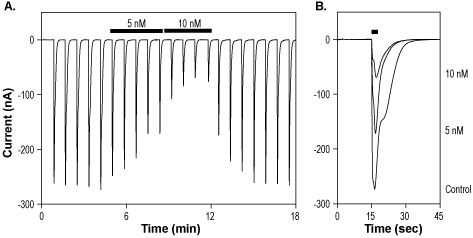Overview
- Foster, A.C. et al. (1992) Mol. Pharmacol. 41, 914.
 Alomone Labs L-689,560 inhibits NMDA receptor channels expressed in Xenopus oocytes.A. Representative time course of NR1/NR2A currents, elicited by transient stimulations with 100 µM glutamate + 100 µM glycine every 50 sec, while membrane potential was held at -60 mV. 4 min applications of 5 nM and 10 nM L-689,560 (#L-225) reversibly inhibit current amplitude. B. Superimposed current traces from the recording shown in A, following application of control, 5 nM and 10 nM L-689,560 (as indicated). Transient stimulation is indicated by the top horizontal bar.
Alomone Labs L-689,560 inhibits NMDA receptor channels expressed in Xenopus oocytes.A. Representative time course of NR1/NR2A currents, elicited by transient stimulations with 100 µM glutamate + 100 µM glycine every 50 sec, while membrane potential was held at -60 mV. 4 min applications of 5 nM and 10 nM L-689,560 (#L-225) reversibly inhibit current amplitude. B. Superimposed current traces from the recording shown in A, following application of control, 5 nM and 10 nM L-689,560 (as indicated). Transient stimulation is indicated by the top horizontal bar.
- Foster, A.C. et al. (1992) Mol. Pharmacol. 41, 914.
- Black, S.A. et al. (2014) Front. Cell Dev. Biol. 2, 45.
L-689,560 is a potent and selective antagonist at the glycine site of N-methyl-D-aspartate (NMDA) receptors. L-689,560 behaves as a full antagonist and competes with glycine for the receptors binding site1. It selectively inhibits [3H]-glycine binding in rat cortex membranes with an IC50 value of 7.4 nM1.
NMDA receptors are heterotetrameric channels formed by the assembly of two obligatory GluN1 and two GluN2/GluN3 subunits. They play an important role in a variety of cellular processes and brain functions such as, synaptic plasticity, addiction and stroke, and mediate physiological functions such as learning and memory formation and participates in glutamate excitotoxicity2.
L-689,560 (#L-225) is a highly pure, synthetic, and biologically active compound.

